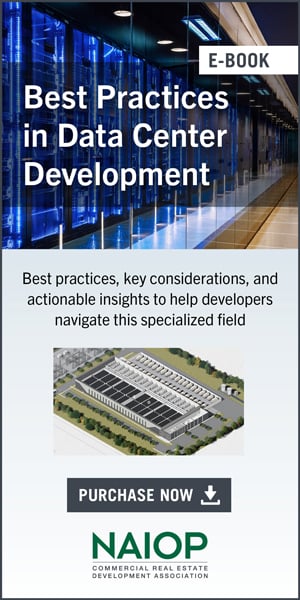The Sustainability Officer and Real Estate Operations

Corporate sustainability efforts vary widely in their approaches to real estate.
SUSTAINABILITY IS becoming a big issue in commercial real estate. For real estate developers and owners, it typically involves considering factors such as location, site design, architecture, stormwater management, LEED or other certifications, energy efficiency and emissions from HVAC systems. For the owner-occupant or tenant, it may involve interior buildouts, workplace safety and health, solid waste disposal and other issues.
Different industries have different real estate sustainability concerns. Many companies focus much of their sustainability attention on their core business activities. This may mean that real estate-based concerns rank as a lower priority. For example, transportation and package delivery companies may highlight vehicle emissions reductions rather than sustainability issues at their warehouses or offices. A financial services firm with offices in many cities may report its sustainability accomplishments in terms of the carbon footprint of employee travel rather than on the emissions of the HVAC plant in each building, over which it likely has no control.
The nature of other industries makes them less able to focus on certain sustainability issues. For example, a manufacturer may have to be near an interstate highway, a port or a rail line rather than in an area served by transit. But sustainability efforts remain important for these industries, which may, for example, have brownfield remediation issues at their facilities.
In addition to focusing on a company’s own activities, its sustainability efforts may also include the environmental footprints of its suppliers, such as electrical power producers, as well as its employees, customers and products.

Sam Black
How do major companies and employers relate sustainability to their real estate activities? It varies, depending on whether the company is primarily in the real estate business; whether its real estate holdings are a factor in its customers’ experience with the company; and to what extent the firm controls the design and operation of the space it inhabits.
Court Gould, executive director of Sustainable Pittsburgh, a nonprofit group that works with businesses, says companies are responding to expectations about sustainability. “Customers, employees, investors and the public are interested in a firm’s performance relative to its environmental, social and governance (ESG) impacts and are looking for signs of good practice. Many companies are responding by adding a discussion of these ESG issues to their disclosures. At many larger businesses,” Gould adds, “hiring or appointing a sustainability officer/coordinator or vice president is on the rise.” He notes that this role can enable companies to address operational low-hanging fruit such as improving their energy, water and waste efficiencies.
This is a good starting point for a look at the practices of several national firms, whose experience varies by firm and by commercial sector.
Oxford Development
More real estate industry firms are making sustainability part of their branding and operations. Pittsburgh-based Oxford Development Co. provides brokerage, consulting, energy management, investment advising, and project and building management services. Oxford develops, builds and owns office, retail, hospitality and institutional properties throughout the U.S.
The company has been an owner of or service provider for 5.4 million square feet of LEED-certified holdings. “Sustainability is a core company culture,” notes Michael Barnard, a project director at Oxford. “We’re endeavoring to build on this. We see the value for our clients. Customers ask: ‘What are the sustainability aspects of the building? How can the building achieve a certain rating? What is its energy performance?’ Sustainability offers operating value to our clients.”
Yet Oxford has no specific position, office or title relating to sustainability. Instead, as Megan Stearman, director of marketing, explains, “Many of our professionals get training on green management practices, and scores of them are on track to get sustainability certifications. This is very important to the bottom line.”
Stearman adds: “For some clients, sustainability is in their brand already. Office tenants see it as an employee productivity and retention tool. Our residential tenants, especially those in the younger generation, represent a well-educated demographic, and they expect features like proximity to bike and running trails, renewable energy, electric-vehicle chargers, and large bike-storage rooms. We have a 300-unit building where the bike storage area filled up before the garage spaces were leased.”
“In our main markets, the public sector is very committed to bold sustainability goals,” Barnard says. “Sustainability is a way for Oxford to distinguish itself as a leader, and we’ve been active in civic affairs on these issues.”
Ikea
The Ikea Group places responsibility for sustainability both with senior headquarters professionals and with line managers at all 389 of its stores worldwide. Sustainability is part of both the Ikea brand and everyday operations. Almost all Ikea employees receive sustainability training every year. Joseph Roth, U.S. property public affairs manager, points out that the company has, in its global headquarters and at the national level, a separate management and ownership structure for real property. It also has a facilities management team at each store. Sustainability is a factor in store design.
Roth reports that “While we have several LEED-qualified stores, we are building at a global sustainability standard, and we intend that all new store designs will exceed LEED standards.” Building systems embody many aspects of Ikea’s sustainability policies; 90 percent of its U.S. buildings incorporate solar technology, and the company’s U.S. solar and wind assets can meet all of Ikea USA’s power needs.
Each Ikea store’s facilities manager sits on a local sustainability committee that also includes managers from Ikea’s community outreach, food services, marketing, operations and product recovery departments. Jennifer Stockdale, an Ikea marketing specialist, characterizes this committee’s function as a clearinghouse for both bottom-up and top-down sustainability initiatives. The goal is to reduce the store’s environmental footprint and help customers reduce their environmental footprints. Sustainability at Ikea is “everyone’s responsibility,” states Stockdale.
Fairmont Hotels
Fairmont Hotels & Resorts, now part of the AccorHotels Group, operates more than 70 properties in 22 countries. Many of these hotels and resorts are historic structures or are situated in well-known beach, mountain or wildlife habitat areas. The company aims to preserve period architecture and environmental features as part of the Fairmont image.
Local hotel engineering staff often deal with sustainability issues. Guy DeFazio, chief engineer of Fairmont Pittsburgh, calls this the “boots on the ground” approach. DeFazio explains that the engineer is likely to be responsible for indoor air quality, water quality and waste disposal, among other factors. “Good performance in these areas makes the customer and employee environments safer, and adds value that you can leverage into a better hotel product with still-competitive input costs,” he says. Fairmont’s commitment to sustainability is “built into day-to-day operations.”
The company has a central sustainability staff. Its senior sustainability executives are responsible for industry and issue partnerships as well as environmental public communications. When a new hotel is being developed, real estate issues may well be intertwined with sustainability issues. Although the sustainability staff may not be involved in the design of a new hotel, Fairmont’s real estate development staff are also committed to sustainability.
It Starts at the Top
Sustainable Pittsburgh’s Court Gould believes that the CEO ultimately determines whether a company will be content with the low-hanging fruit or whether it will go further to address sustainability issues. “In companies where the CEO is the driver, the sustainability dynamic grows. The sustainability officer becomes an ombudsperson interfacing with all departments. The C-suite integrates sustainability into the corporate strategy, usually starting with facilities but moving into marketing, product development, strategic planning and corporate governance. Some companies cement their commitments by tying them to the annual performance review for senior executives, including the CEO.”
Sam Black, former contributing editor at Development, attorney and past chairman of the Washington, D.C., Smart Growth Alliance




